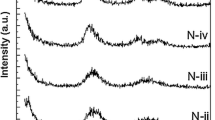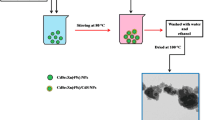Abstract
The UV–VIS spectra analysis of CdS was carried out, and the effective mass approximation model was used to evaluate the size of CdS NPs. CdS nanoparticles were prepared by using chemical bath deposition. The results showed that the highest value of the energy gap was 3.4 eV under the following conditions (Capping (PVA = 900 mg)), where the cutoff wavelength at this value was 364 nm. This indicates a shift toward the short wavelength, while the results of mixing were shown at (Complex agent (cation/:anion ratio 1:3)) ratio, where the energy gap was 3 eV. On the other hand, the results showed that the crystal size is inversely proportional to the change in the capping value and also inversely proportional to the ratio of the complex agent.








Similar content being viewed by others

References
M.G. Burt, The justification for applying the effective-mass approximation to microstructures. J. Phys. Condens. Matter 4, 6651–6690 (1992)
C. Lokhande, P. Patil, H. Tributsch, A. Ennaoui, ZnSe thin films by chemical bath deposition method. Sol. Ener. Mater. Sol. Cells 55(4), 379–393 (1998)
M. Hosokawa, K. Nogi, M. Naito, T. Yokoyama, Nanoparticle Technology Handbook (Elsevier, USA, 2007)
R. Viswanatha, S. Sapra, T. Saha-Dasgupta, D.D. Sarma, Electronic structure of and quantum size effect in III-V and II-VI semiconducting nanocrystals using a realistic tight binding approach. Phys. Rev. B. 72(4), 045333 (2005)
N. Sharma, M. Ganesh, R. Mittal, The non-brown motion of nanoparticles: an impact process model. IEEE Trans. Nanotech. 3(1), 180–186 (2004)
C. Rao, J. Thomas, U. Kulkarni, Nanocrystals: Synthesis, Properties and Applications (Springer, Berlin Heidelberg, 2007)
H. Weller, Quantized semiconductor particles: a novel state of matter for materials science. Adv. Mater. 5(2), 88–95 (1993)
A. Alivisatos, Perspectives on the physical chemistry of semiconductor nanocrystals. J. Phys. Chem. 100(31), 13226–13239 (1996)
L. Kosyachenko,"Solar Cells – Thin-Film Technologies", 1st Ed. InTech, Croatia, (2011)
F. Iacomi, "Nanometer-sized CdS and ZnS clusters in zeolites", Analele Stiintifice Ale Universitii" ALICUZA" IASI Tomul XLV - XLVI, s. Fizica Stării Condensate, 287–291 (1999–2000)
G. Banfi, V. Degiorgio, D. Ricard, Nonlinear optical properties of semiconductor nanocrystals. Adv. In Phys 47(3), 447–510 (1998)
N. Donkor, "Structural and optoelectronic properties of Copper, Zinc, Cadmium Lead chalcogenide nanocrystalline thin films deposited at the water-toluene interface", Ph.D. thesis, Kwame Nkrumah of Science and Technology, College of Science, Department of Chemistry, Kumasi, Ghana, (2013)
E. Leite, C. Ribeiro, Crystallization and Growth of Colloidal Nanocrystals (Springer-Verlag, New York, 2012)
G. Stansfield, "Properties of Nanocrystalline Thin Films of Metals and Semiconductors Obtained at the Water-Oil Interface", Ph.D. Thesis, Faculty of Engineering and Physical Sciences, University of Manchester, Manchester, U.K, (2012)
L. Brus, Electron–electron and electron-hole interactions in small semiconductor crystallites: the size dependence of the lowest excited electronic state. J. Chem. Phys. 80(9), 4033–4409 (1984)
T. Kippeny, L. Swafford, S. Rosnethal, Semiconductor nanocrystals: a powerful visual aid for introducing the particle in a box. J. Chem. Educ. 79(9), 1094–1100 (2002)
J. Tauc, R. Grigorovici, A. Vancu, Optical properties and electronic structure of germanium. Phys. Stat. Sol 15(2), 627–637 (1996)
V. Kumar, R. Kumar, S.P. Lochab, N. Singh, Effect of swift heavy ion irradiation on nanocrystalline CaS: Bi phosphors: structural, optical and luminescence studies. Nucl. Instr. Meth. Phys. Res. Sect. B: Beam Interact. Mater. Atoms 262(2), 194–200 (2007)
R. Sarkar, C. Tiwary, P. Kumbhakar, S. Basu, A. Mitra, Yellow-orange light emission from Mn2+ doped ZnS nanoparticles. Phys. E: low-Dimension. Syst. Nanostruct. 40(10), 3115–3120 (2008)
Y. Zhang, “ Ag nanocrystal suface capped with thiourea.” Chin. J. Inorg. Chem. 15(5), 595 (1999)
Y. Jian-Xi, Z. Gao-Ling, H. Gao-Rong, the effect of the ratio of thiourea to Cd2+ on the properties of US nanoparticle. Microelectron. Eng. 66, 115–120 (2003)
H.F. Al-Taay, Preparation and characterization of chemical bath deposition synthesis CdS nanocrystalline thin films. Iraqi J. Sci. 58(1C), 454–461 (2017)
A.M. Kadim, W.R. Saleh, Morphological and optical properties of CdS quantum dots synthesized with different pH values. Iraqi J. Sci. 58(3A), 1207–1213 (2017)
S.M. Shaban, K.T. Mahdi, A.S. Ahmed, Characterization of CdS nanoparticles prepared by liquid – liquid interface reaction. Iraqi J. Sci. 57(1C), 609–617 (2016)
M.A.H. Al-Beayaty, L.K. Abbas, R.K. Mohammed, Structural, optical and morphological characterization of Cdse/Cds core / shell quantum dots synthesized via chemical bath. Iraqi J. Sci. 62(11), 4323–4332 (2021)
Funding
The present research did not receive any grant from funding agencies in the public, commercial or not-for-profit sectors. So this personal work and the statement of declaration of interests are only mine and support has been subjected during the research work for the past year.
Author information
Authors and Affiliations
Corresponding author
Ethics declarations
Conflict of interest
Author has no conflicts of interest to declare.
Additional information
Publisher's Note
Springer Nature remains neutral with regard to jurisdictional claims in published maps and institutional affiliations.
Rights and permissions
Springer Nature or its licensor (e.g. a society or other partner) holds exclusive rights to this article under a publishing agreement with the author(s) or other rightsholder(s); author self-archiving of the accepted manuscript version of this article is solely governed by the terms of such publishing agreement and applicable law.
About this article
Cite this article
Ali, O.A. Estimated the nanoparticles size of CdS from UV–Vis spectrum absorption by effective mass approximation model (EMA) using capping and complex agent. J Opt 53, 1551–1556 (2024). https://doi.org/10.1007/s12596-023-01296-6
Received:
Accepted:
Published:
Issue Date:
DOI: https://doi.org/10.1007/s12596-023-01296-6



